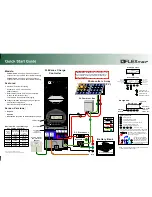
Kit Operation
CY4502 EZ-
PD™ CCG2 Development Kit Guide, Doc. No. 001-96601 Rev. *G
20
Table 3-4. Jumper Settings for CCG1 Host Board
Jumper Position
Comments
J4
Short 2-5
Board gets powered from USB 3.0 connector (J12)
J6
Closed
Provision for measuring current consumption on VCONN
J8
Short 2
–4
CC2 Rp selection for 1.5 A current advertisement
J10
Short 2
–4
CC1 Rp selection for 1.5 A current advertisement
J11
Closed
Provision for measuring current consumption of CCG1
4. Ensure that the
CCG1 Client board
) has the jumper settings listed in
Figure 3-11. CCG1 Client board
Table 3-5. Jumper Settings for CCG1 Client board
Jumper
Position
Comments
J5
Short 2
–4
CC2 Rp selection for 1.5 A current advertisement
J6
Short 2
–4
CC1 Rp selection for 1.5 A current advertisement
J10
Closed
Provision for measuring current consumption on VCONN
J11
Short 2
–4
Board gets powered from mini USB connector (J7).
J12
Closed
Provision for measuring current consumption of CCG1
Note:
Other jumpers on the CCG1 Client board, not listed in
, can be retained in any position for testing the
CY4502 board. For more details on the CCG1 Client board, refer to the
5. Configure the CY4502 board for any of the applications discussed in
6. Connect the CCG1 Host board to the PC (USB Host) using a USB 3.0 A-B cable at connector J12. LED1 on the
CCG1 Host board glow to indicate that the board is powered.
7. Power the CCG1 Client board by connecting a USB Mini cable at connector J7. LED2 on the CCG1 Client board
glows to indicate that the board is powered.
8. Connect one of the Type-C plugs of the CY4502 board to the CCG1 Host board at connector J14 of the CCG1
Host board.
J6
– Short 2-4
J5
– Short 2-4
J10
– Closed
J12
– Closed
J11
– Short 2-4















































